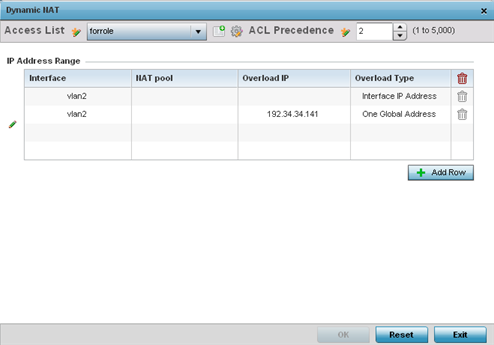Adding and Editing Bridge NAT Configurations
Using bridge NAT, a tunneled VLAN (extended VLAN) is created between the NoC and a remote location. When a remote client needs to access the Internet, Internet traffic is routed to the NoC, and from there routed to the Internet. This increases the access time for the end user on the client.
To add or edit a bridge NAT configuration that can be applied to a profile:
-
Select Add to create a new Bridge VLAN configuration, Edit to modify an existing configuration or Delete to remove a configuration.

-
Select the ACL whose IP rules are applied to this policy based forwarding rule. A new ACL can be defined by selecting the Create icon, or an existing set of IP ACL rules can be modified by selecting the Edit icon.
-
Use the IP Address Range table to configure IP addresses and address ranges used to access the Internet.
ACL Precedence
Set the priority (from 1 - 5000) for the ACL. The lower the value, the higher the priority assigned to these ACL rules.
Interface
Lists the outgoing layer 3 interface on which traffic is re-directed. The interface can be an Access Point wwan1 or pppoe1 interface. Traffic can also be redirected to a designated VLAN.
NAT Pool
Displays the NAT pool used by this bridge NAT entry. A value is only displayed only when Overload Type has been set to NAT Pool.
Overload IP
Lists whether the single global address supports numerous local addresses.
Overload Type
Displays the overload type for this policy based forwarding rule.
-
Select + Add Row to set IP address range settings for thebridge NAT configuration.

-
Select OK to save the changes made within the screen. Select Reset to revert to the last saved configuration.
